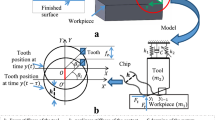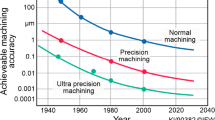Abstract
Purpose
A spindle feed system is continuously subjected to cutting forces, cutting heat and frictional heat during machining processes, which interact to form a complex, nonlinear and thermal-force coupling field. The coupling field causes deformations and vibrations of the mechanism that affect the machining accuracy. Therefore, determining the thermal-force coupling dynamic characteristics of the mechanism is beneficial, as it lays the theoretical foundations for accurate error compensation and the design and optimization of the spindle feed system.
Methods
The deformation of the spindle feed system in actual working processes is approached by modeling, simulation and verification. Based on the theory of mechanics and heat transfer, the models for the transient milling force and the temperature field are established to obtain the real-time, dynamic cutting force and the associated heat values. A thermo-mechanical coupling model is also deduced, and the deformations generated by the cutting force and heat are simulated using the finite element method. Moreover, the thermo-mechanical coupling deformations of the system are emulated. The above deformation results are tested and confirmed.
Conclusion
This paper establishes the deformation rules under the cutting force and cutting heat as well as their associated coupling effects. When studying thermo-mechanical coupling, the initial deformations of the ball screw are dominated by the cutting forces. The effects of heat on the X-direction deformations gradually exceed the effects of the cutting forces. The Y-direction deformations are primarily caused by the forces, with little influence from the heat. The Z-direction deformations are mainly caused by the heat, with negligible influence from the forces.


















Similar content being viewed by others
References
Hu S et al (2015) Investigation into effect of thermal expansion on thermally induced error of ball screw feed drive system of precision machine tools. Int J Mach Tools Manuf 97:60–71
Altintas Y, Verl A, Brecher C et al (2011) Machine tool feed drives. CIRP Ann Manuf Technol 60:779–796
Yun WS, Kim SK, Dong WC (1999) Thermal error analysis for a CNC lathe feed drive system. Int J Mach Tools Manuf 39:1087–1101
Wu CH, Kung YT (2003) Thermal analysis for the feed drive system of a CNC machine centre. Int J Mach Tools Manuf 43:1521–1528
Mayr J, Jedrzejewski J, Uhlmann E et al (2012) Thermal issues in machine tools. CIRP Ann Manuf Technol 61:771–791
Xu ZZ, Liu XJ (2014) Study on thermal behavior analysis of nut/shaft air cooling ball screw for high precision feed drive. Int J Precis Eng Manuf 15:123–128
Huang SC (1995) Analysis of a model to forecast thermal deformation of ball screw feed drive systems. Int J Mach Tools Manuf 35:1099–1104
Min X, Jiang S (2011) A thermal model of a ball screw feed drive system for a machine tool. Proc Inst Mech Eng 225:186–193
Horejs O (2007) Thermo-mechanical model of ball screw with non-steady heat sources. In: Proceedings of the international conference on thermal issues in emerging technologies: theory and application
Ramesh R, Mannan MA, Poo AN (2000) Error compensation in machine tools. Int J Mach Tools Manuf 40:1235–1256
Altintas Y, Eynian M, Onozuka H (2008) Identification of dynamic cutting force coefficients and chatter stability with process damping. CIRP Ann Manuf Technol 57:371–374
Powałka B (2008) Roundness error prediction in valve seat machining based on cutting force model and machine tool system dynamics. CES Manuf Sci Technol 32:45–57
Kaymakci M, Kilic ZM, Altintas Y (2012) Unified cutting force model for turning, boring, drilling and milling operations. Int J Mach Tools Manuf 54:34–45
Tan L, Zhang DH et al (2015) Influence of tool geometrical parameters on milling force and surface integrity in milling titanium alloy. China Mech Eng 26:737–742
Budak E (2006) Analytical models for high performance milling. Part I: Cutting forces, structural deformations and tolerance integrity. Int J Mach Tools Manuf 46:1478–1488
Chen W, Xue J, Tang D et al (2009) Deformation prediction and error compensation in multilayer milling processes for thin-walled parts. Int J Mach Tools Manuf 49:859–864
Yang JG, Fan KG, Du ZC (2013) Technique of real-time error compensation on NC machine tools. China Machine Press, Beijing
Fan KG, Li HL, Yang JG (2015) Traceability analysis and coupling compensation for guide way-induced errors in large CNC gantry guide way grinder. Int J Adv Manuf Technol 80:907–919
Li LG, Wang AM et al (2014) Finite element analysis of 3D milling of side and face milling cutter based on the mechanical–thermal coupling field. Manuf Autom 16:45–49
Zhang DJ (2008) Thermo-mechanical coupling modeling and experimental study of cutting processing. Shanghai Jiao Tong University, Shanghai
Ma C, Yang J et al (2017) Dynamic thermal-structure coupling analysis and experimental study on ball screw feed drive system of precision machine tools. Appl Mech Mater 868:124–135
Acknowledgements
This work is financially supported by the National Natural Science Foundation of China (Nos. 51575272, 51775277).
Author information
Authors and Affiliations
Corresponding author
Additional information
Publisher's Note
Springer Nature remains neutral with regard to jurisdictional claims in published maps and institutional affiliations.
Rights and permissions
About this article
Cite this article
Ye, W., Guo, Y., Liang, R. et al. Research on Thermo-Mechanical Coupling Deformation for the Ball Screw of Machine Tool Spindle Feed System. J. Vib. Eng. Technol. 8, 443–454 (2020). https://doi.org/10.1007/s42417-019-00182-5
Received:
Revised:
Accepted:
Published:
Issue Date:
DOI: https://doi.org/10.1007/s42417-019-00182-5




